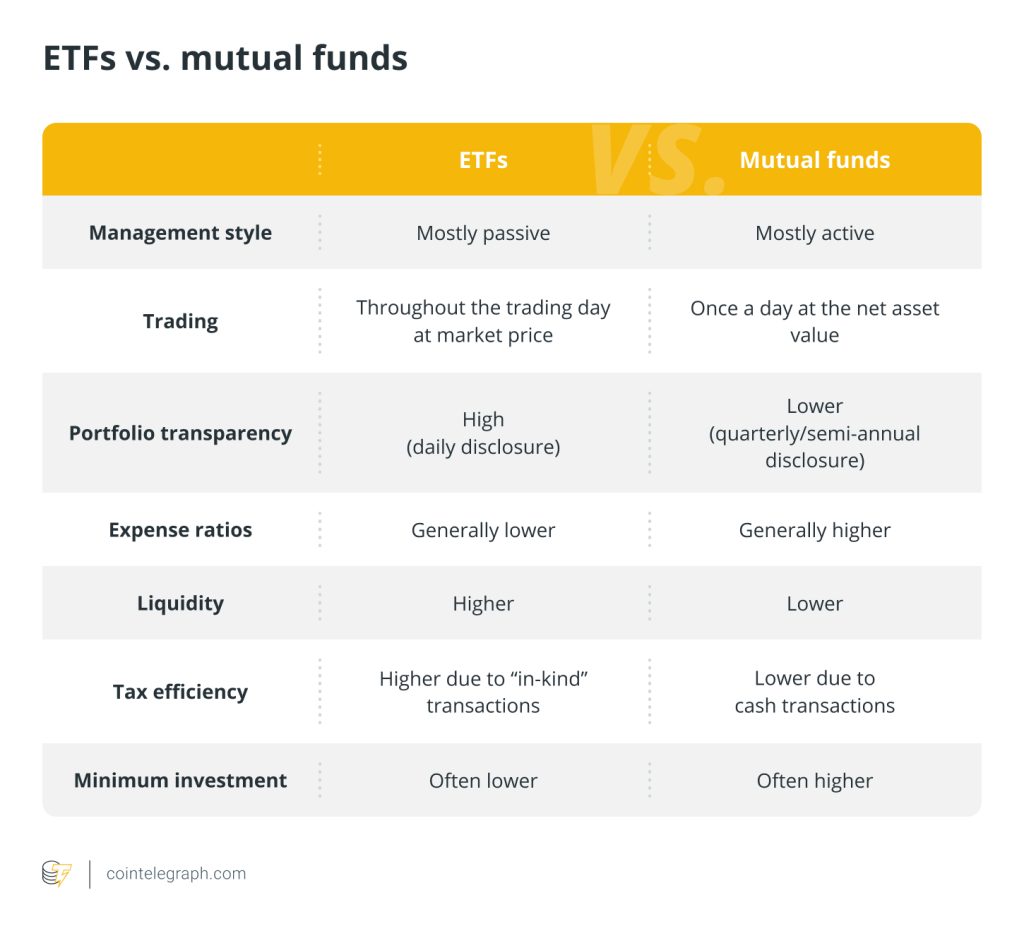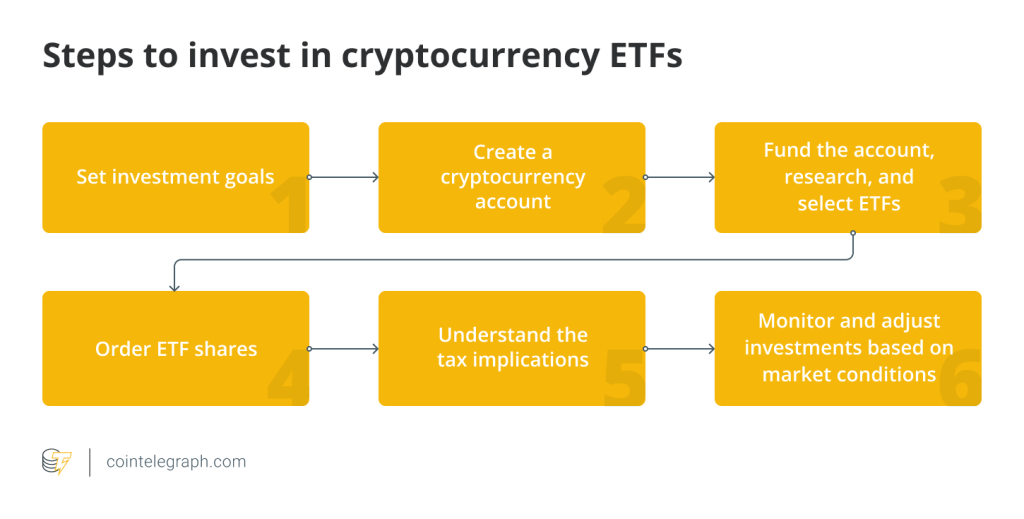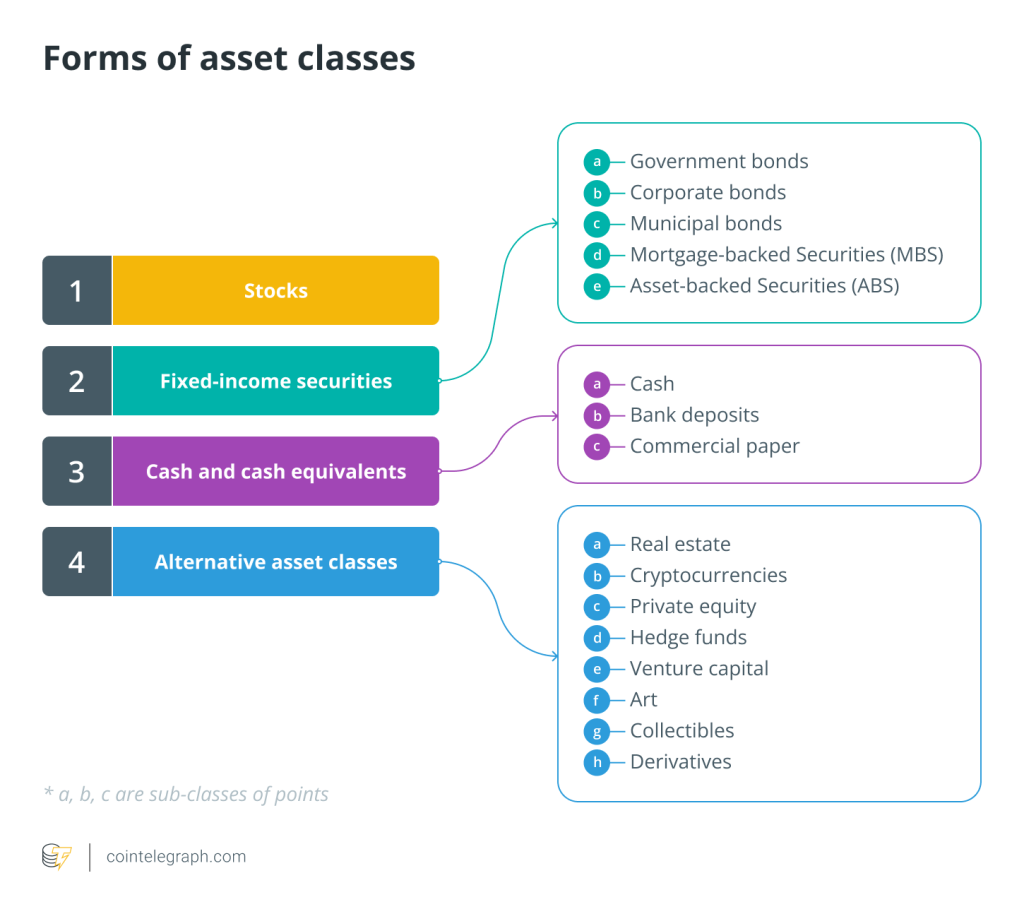ETFs vs. mutual funds: What’s the difference?


What are exchange-traded funds?
Exchange-traded funds (ETFs) are collective investment schemes that aggregate capital from various investors to acquire a diversified array of assets such as equities, bonds, commodities, cryptocurrencies or a mixture thereof. They are traded on public stock exchanges like individual stocks, ensuring liquidity throughout the trading day.
Traditional ETFs
Traditionally, ETFs adhere to a passive investment strategy, aiming to mimic the performance of a specified benchmark index. The structure typically involves a trust or a company that holds the underlying assets and issues shares representing a proportional interest in these assets.
Each share of an ETF reflects a portion of the fund’s total asset base, granting shareholders a share of the fund’s returns, although not direct ownership of the underlying assets.
Cryptocurrency ETFs
In contrast to traditional ETFs, cryptocurrency ETFs follow the performance of different cryptocurrencies. Traditional investors can easily access the cryptocurrency market through these funds without holding digital assets directly. The Bitwise 10 Crypto Index Fund, which provides direct exposure to the top 10 largest cryptocurrencies, is an example of a cryptocurrency ETF.
With a diverse portfolio of cryptocurrencies, crypto ETFs generally distribute investor risk. Although they provide regulatory compliance and accessibility, their success depends on market acceptability and regulatory approval. For instance, BlackRock’s application for a spot Bitcoin ETF, filed on June 15, 2023, still awaits approval from the United States Securities and Exchange Commission (SEC).
Key concepts related to ETFs
Passive investments and index tracking
Contrary to actively managed funds, ETFs primarily adopt a passive investment approach, striving to mirror the performance of a designated market index. This passive management involves less administrative overhead and lower discretionary decision-making, often resulting in a lower expense ratio.
In traditional finance, this is often achieved through index funds. Similarly, investors may access digital assets without active management in the cryptocurrency industry.
As ETFs aim to meticulously track their benchmark indexes by holding a portfolio of assets that accurately or closely replicate the composition and performance of the indexes, they utilize various indexing strategies.
These include full replication, stratified sampling or optimization to minimize tracking error, each with unique advantages and trade-offs concerning cost and complexity. Tracking error is the standard deviation between the return on an investment and its benchmark.

In traditional finance, ETFs may mirror stock or bond indexes, giving investors diversified exposure. In contrast, in the crypto space, ETFs track digital asset indexes, allowing investors to participate in the broader cryptocurrency market.
ETF liquidity and expense ratios
Liquidity in conventional ETFs relates to how simple it is to acquire or sell shares on the stock exchange. Lower bid-ask spreads are frequently linked to higher liquidity, which lowers trading costs for investors. Overall results are impacted by expense ratios, which refer to the fund’s operating costs as a percentage of assets. Investors typically want lower expense ratios since they result in lower costs and better long-term profitability.
Although crypto ETFs and traditional ETFs are comparable, they are part of an industry that is known for greater volatility. The liquidity of the underlying cryptocurrencies influences the ease of trading in cryptocurrency ETFs. Expense ratios of crypto ETFs could differ from their traditional counterparts in terms of cost structures due to considerations like custody and security procedures unique to digital assets. Investors evaluate the overall appeal of cryptocurrency ETFs based on these variables.

What are mutual funds?
Mutual Funds are pooled investment vehicles managed by professional fund managers. They aggregate capital from multiple investors to purchase a diversified portfolio of stocks, bonds or other securities.
Mutual Funds have a more centralized management structure, where the fund managers make decisions regarding asset allocation, security selection and timing of purchases and sales. Each investor owns shares in the mutual fund, representing a portion of the fund’s holdings.
Key concepts related to mutual funds
Active management
In order to outperform benchmarks, fund managers in traditional mutual funds use active management, which focuses on stock selection and market timing. The goal of this strategy is to produce alpha that outpaces market returns.
Conversely, active management in crypto mutual funds includes managing the erratic cryptocurrency market. Managers prioritize market trends and technical advancements when strategically choosing and rebalancing digital assets to optimize returns. Examples include Pantera Capital and Grayscale Bitcoin Trust, which manage diversified cryptocurrency portfolios or single-asset crypto funds.
Furthermore, management fees in traditional mutual funds cover the cost of professional management. In crypto mutual funds, similar fees apply, compensating managers for overseeing digital asset portfolios and navigating volatile markets.
In contrast to the established and regulated environment of traditional mutual funds, the dynamic nature of the digital asset market means that crypto funds frequently call for a proactive approach.
Liquidity and expense ratios in mutual funds
Traditional mutual funds often have strong liquidity, making it straightforward for investors to purchase or sell shares at any time throughout the business day at the net asset value. Additionally, returns are impacted by expense ratios that account for management and operational costs. That said, lower expense ratios are generally favored.
On the other hand, different cryptocurrency mutual funds encounter different liquidity issues in the unstable market, with certain assets having a restricted number of trading pairings. As a result, it might be less seamless to buy and sell digital assets. Technology and security demands can lead to greater expense ratios in cryptocurrency funds. Investors often weigh these factors carefully in choosing between traditional and crypto mutual funds.

How are ETFs and mutual funds taxed?
Investors usually pay taxes on capital gains and income distributions for conventional ETFs and mutual funds. Capital gains taxes emerge when investors sell fund shares at a profit, subject to short-term or long-term rates depending on the holding period. The fund’s interest and dividend income is likewise subject to taxation.
Crypto-focused ETFs and mutual funds face similar tax principles. When investors sell fund shares, they are subject to capital gains tax, which varies depending on the type of gain — long-term or short-term — on the cryptocurrency assets held by the fund.
The particular difficulty associated with cryptocurrency funds is the dynamic and intricate taxation of cryptocurrencies, which takes into account factors like airdrops, hard forks and the precise identification of assets to determine gains or losses.
Differences between exchange-traded funds and mutual funds
This section highlights the fundamental differences between ETFs and mutual funds across various parameters below:

SEC registration and disclosure requirements for ETFs and mutual funds
Registration and disclosure requirements for ETFs
ETFs, whether traditional or crypto-focused, are required to register with the SEC under the Investment Company Act of 1940. They are typically structured as open-end funds or unit investment trusts.
Additionally, ETFs are mandated to disclose their holdings on a daily basis. This disclosure includes detailed information about the fund’s portfolio holdings, the performance of the fund, and the fund’s expenses. Moreover, ETFs are required to file quarterly and annual reports and disclose material events to the SEC.
Registration and disclosure requirements for mutual funds
Like ETFs, traditional and crypto mutual funds are also required to register with the SEC under the Investment Company Act of 1940. Also, funds must file Form N-1A, disclosing essential information like investment objectives, fees and risks. Moreover, mutual funds are also required to file quarterly and annual reports and disclose material events to the SEC.
Written by Tayyub Yaqoob






… [Trackback]
[…] Read More here on that Topic: x.superex.com/academys/beginner/1963/ […]
… [Trackback]
[…] Read More here on that Topic: x.superex.com/academys/beginner/1963/ […]
… [Trackback]
[…] Read More Information here to that Topic: x.superex.com/academys/beginner/1963/ […]
… [Trackback]
[…] Find More to that Topic: x.superex.com/academys/beginner/1963/ […]
… [Trackback]
[…] Read More on that Topic: x.superex.com/academys/beginner/1963/ […]
… [Trackback]
[…] Find More Information here on that Topic: x.superex.com/academys/beginner/1963/ […]
… [Trackback]
[…] Find More on to that Topic: x.superex.com/academys/beginner/1963/ […]
… [Trackback]
[…] Information to that Topic: x.superex.com/academys/beginner/1963/ […]
… [Trackback]
[…] Read More to that Topic: x.superex.com/academys/beginner/1963/ […]
… [Trackback]
[…] There you can find 88754 more Info to that Topic: x.superex.com/academys/beginner/1963/ […]
… [Trackback]
[…] There you will find 42192 additional Info to that Topic: x.superex.com/academys/beginner/1963/ […]
… [Trackback]
[…] Read More to that Topic: x.superex.com/academys/beginner/1963/ […]
… [Trackback]
[…] Find More here to that Topic: x.superex.com/academys/beginner/1963/ […]
… [Trackback]
[…] Find More Information here to that Topic: x.superex.com/academys/beginner/1963/ […]
… [Trackback]
[…] Read More Information here to that Topic: x.superex.com/academys/beginner/1963/ […]
… [Trackback]
[…] Find More Info here to that Topic: x.superex.com/academys/beginner/1963/ […]
… [Trackback]
[…] There you can find 62782 more Info on that Topic: x.superex.com/academys/beginner/1963/ […]
… [Trackback]
[…] Info on that Topic: x.superex.com/academys/beginner/1963/ […]
… [Trackback]
[…] Find More here on that Topic: x.superex.com/academys/beginner/1963/ […]
… [Trackback]
[…] Read More on on that Topic: x.superex.com/academys/beginner/1963/ […]
… [Trackback]
[…] Here you can find 47740 more Info on that Topic: x.superex.com/academys/beginner/1963/ […]
… [Trackback]
[…] Find More Information here on that Topic: x.superex.com/academys/beginner/1963/ […]
… [Trackback]
[…] Read More here to that Topic: x.superex.com/academys/beginner/1963/ […]
… [Trackback]
[…] Info on that Topic: x.superex.com/academys/beginner/1963/ […]
… [Trackback]
[…] Information on that Topic: x.superex.com/academys/beginner/1963/ […]
… [Trackback]
[…] There you will find 86002 more Info on that Topic: x.superex.com/academys/beginner/1963/ […]
… [Trackback]
[…] There you will find 51312 more Information on that Topic: x.superex.com/academys/beginner/1963/ […]
… [Trackback]
[…] Read More on to that Topic: x.superex.com/academys/beginner/1963/ […]
… [Trackback]
[…] Find More Info here to that Topic: x.superex.com/academys/beginner/1963/ […]